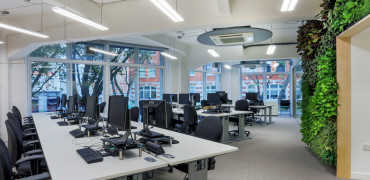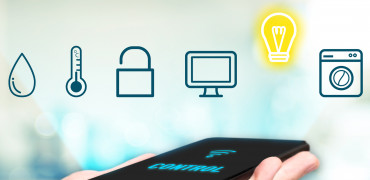Retrofitting smart technology to commercial buildings can cut energy bills by 18% and there are many options available to building owners to help achieve this; especially with Minimum Energy Efficiency Standards coming into force in April 2018 which will make it illegal to rent buildings with an Energy Performance Certificate (EPC) below grade E.
For example, to be a “smarty pants office” a commercial building could retro-fit systems such as smart thermostats, cloud-based building management systems, occupancy sensors for lighting and air conditioning and smart systems to improve building security, making a difference to how it operates, its energy performance and making it more desirable for premium tenants.
Class A, B and C
If you aren’t familiar with the different classes of office building, they are typically graded under 3 categories in the UK; Class A, Class B and Class C (FYI these grades are different to the energy rating grades).
Grading is usually based on considerations such as building age, location, infrastructure, technology, architecture and on-site/in-house amenities – as listed on Spatial.co.uk.
Class A commercial office buildings are desirably located, modern in their infrastructure, and have a good range of features and amenities. One of the main highest grading qualities however is the buildings infrastructure technology allowing building owners to achieve the highest standards of efficiency.
This technology will often include industry-leading solutions for security, IT and HVAC systems in order to attract premium tenants and higher rents.
Class B buildings are usually older, have a lower class of technology and amenities. Class C buildings are at the bottom end and usually have a long history of tenant occupancy, have out-of-date furnishings, limited technologies and poor amenities. Of course this means that they will demand a lower rent which is ideal for many tenants that require low-cost office space.
Getting to top of the class
Building managers have the ability to take their buildings from Class C and Class B to Class A by implementing a number of updates both aesthetically and in the buildings infrastructure.
Here are some smart technology suggestions that can be retro-fitted in a majority of buildings to help with this journey by improving the energy efficiency and energy rating.
Smart and intuitive BMS
Installing lighting sensors and temperature sensors that feedback to Building Management Systems (BMS) in real time is the smart way to keep occupants in buildings comfortable while making a conscious effort to reduce energy use.
Traditionally however Building Management Systems are associated with large commercial equipment but with new technologies like wireless controller, managing the facilities in all different sized buildings is much easier – and smarter.
The recent popularity of controlling your home via a smart phone or other smart devices has given homeowners the flexibility to monitor and control their heating, lighting and even security systems from anywhere in the world. And this type of technology is also available in the commercial sector.
Smart device control apps like MELCloud allows building managers to monitor and control heating and air conditioning remotely via the internet as well as benefit from additional features like localised weather information, frost protection, 7 day multi-programmable timers and holiday mode.
Control on the HVAC system can also be more precise – beyond just controlling whether units are on or off. Different types of heating or cooling modes can be chosen and adjustments can be made to fan speed, vane positions and room temperature. Errors reports can also be viewed to help with diagnosing any problems.
Due to its range of flexibility, users of this type of App can range from single users with single air conditioning systems in single buildings to larger users with multiple properties and multiple systems; allowing everyone to have smarter control of their buildings and minimise energy use – a concept that premium building tenant may soon expect as standard.
Intelligent HVAC occupancy sensors
Many new air conditioning indoor units such as our range from Mitsubishi Electric include smart sensor technology like the 3D i-See Sensor (unique to Mitsubishi Electric) which is one of the most advance sensor technologies available in the HVAC market.
This particular technology is embedded into the indoor unit and offers a collection of 8 sensors that rotate a full 360 degrees in 3 minute intervals. The sensors are able to detect not only if a space is occupied but also how many people are present. Heating and cooling is then adjusted to the exact requirements of the occupants, providing a personalised working environment and ensuring energy efficiency.
This kind of intelligent sensor technology can also detect when occupancy levels in the space have dropped or increased to around 30%, adjusting the temperature to accommodate the change.
Energy efficiency is also further enhanced by the sensors ability to detect an empty room and automatically stop once a room is empty for 60-180 minutes.
Smart Industry-leading technology
Another way to improve building class and energy efficiency rating is with the installation of smarter HVAC systems.
Many VRF air conditioning systems use heat recovery as an energy efficient way to utilise excess heat to provide hot water and to provide heat to other products like Air Curtains.
Air Curtains help with building efficiency right from the front door.
Popular in retail applications and offices, they lower energy usage by reducing the amount of heating or cooling required by a building with an open/opening door. They do this by blowing conditioned air down over the door way in order to retain the indoor temperature and repel the outdoor temperature as well as fumes, dust and insects.
The smarter way to have an Air Curtain however is to choose a heat pump Air Curtain which is the energy efficient alternative to traditional electric because it upgrades naturally occurring low temperature heat into useful high temperature heat. In comparison to the traditional electric Air Curtain, a heat pump Air Curtain is about 300% more efficient which is why it is one of the smartest options available for commercial buildings.
Other smart HVAC systems include VRF air conditioning with lower levels of refrigerant.
Mitsubishi Electric Hybrid VRF systems utilise water between the indoor units which means the system has 30% less refrigerant and costly leak detection equipment is avoided.
The use of water also means it can utilise plastic piping with is a much more flexible option.
Choosing this kind of HVAC system is also the smart choice when it comes to complying with legislation. The Governments F-Gas phase down which is a huge subject affecting everyone who deals with air conditioning, means that lower refrigerant volume systems and alternative refrigerant systems are the best way to future proof buildings.
R32 air conditioning systems use an alternative refrigerant called R32 and has a low Global Warming Potential. To find out more about R32 air conditioning please visit www.timeforr32.co.uk/home
If you’re looking to change your HVAC systems its worth researching the options that are best for you.
Ellina Webb is a Senior Marketing Executive at Mitsubishi Electric
If you have any questions about this article, you can contact us via email. Or if you would like to tweet us, please follow our MEUK_LES twitter page.
We upload new articles every week so remember to check back regularly.
You can also sign up for our monthly newsletter below.
Choosing the right HVAC system is also the smart choice when it comes to complying with legislation.


